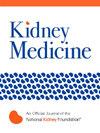IF 3.2
Q1 UROLOGY & NEPHROLOGY
引用次数: 0
摘要
理由& 目标虚弱与肾移植受者发病率和死亡率的增加有关。我们假设虚弱可能是由于肌肉形态变化导致肌肉功能减退所致。这项针对肾移植候选者的试验通过专门针对受影响的主要肌肉群来测试虚弱的可逆性。结果基线、6 个月和 12 个月短期体能测试、步态速度、握力、30 秒内从坐到站、36 项简表调查、患者报告结果测量信息系统-29、肌肉活检光镜和电子显微镜以及免疫组化分析方法配对双尾 t 检验、单因素重复测量方差分析。运动干预参与者在以下方面有明显改善:短期体能测试(Short Physical Performance Battery),基线为 5.2(95% CI,3.6-6.7),6 个月为 6.9(95% CI,5.2-8.5;P< 0.001),12 个月为 7.2(95% CI,5.6-8.8;P< 0.001);基线手部握力为 14.3 公斤(95% CI,10.3-18.4),6 个月为 16.3 公斤(95% CI,10.3-18.4),12 个月为 16.2 公斤(95% CI,5.6-8.8)。4),6 个月为 16.9 千克(95% CI,13.1-20.8;P <;0.05),12 个月为 17.4 千克(95% CI,13.9-21.0;P <;0.05);基线坐立 30 秒,8.0(95% CI,3.8-12.2),6 个月为 12.7(95% CI,8.2-17.1;P <;0.001),12 个月为 16.2(95% CI,10.7-21.7;P <;0.001)。运动组 12 个月的肌肉纤维直径增加了 18.6 μm(95% CI,8.4-28.5;P = 0.003)。肌肉萎缩的免疫组织学标志物的表达明显减少。细胞色素 c 氧化酶复合物 IV 的线粒体氧化功能免疫组织学评分的平均差异提高了 1.00(95% CI,0.71-1.29;P <;0.001),ATP5I 增加了 0.74(95% CI,0.49-0.99;P <;0.001)。线粒体数量的增加未达到统计学意义(P = 0.096)。结论一年的肌肉康复治疗可显著改善体能指标,同时显著改善肌肉形态。一项随机对照临床试验对潜在的肾移植受者进行了肌肉康复治疗测试。经过一年的治疗后,运动患者的肌肉力量和行走速度明显改善,在多个健康和保健领域的自我评估也有所改善;而对照组患者的这些结果并没有改善。对运动患者进行的肌肉活检显示,肌肉纤维增大,肌肉新陈代谢改善,肌肉萎缩的生物标志物明显减少。肌肉康复治疗显著改善了肾移植候选者的健康感知、力量的客观测量以及肌肉组织的显微外观。本文章由计算机程序翻译,如有差异,请以英文原文为准。
Resistance-Based Muscle Therapy, Frailty, and Muscle Biopsy Findings in Kidney Transplant Candidates: A Clinical Trial
Rationale & Objective
Frailty is associated with increased morbidity and mortality in kidney transplant recipients. We hypothesized that frailty may be attributable to diminished muscle function associated with muscle morphologic changes. This trial in kidney transplant candidates tested the reversibility of frailty by specifically targeting the affected major muscle groups.
Study Design
Randomized clinical trial.
Setting & Participants
Kidney transplant candidates.
Exposure
Supervised, resistance-based muscle therapy program delivered for 1 hour, 2 times per week for 1 year.
Outcomes
Baseline, 6-month, and 12-month Short Physical Performance Battery, gait speed, grip strength, sit-to-stand in 30 s, 36-item Short Form Survey, Patient-Reported Outcomes Measurement Information System-29, and muscle biopsy light and electron microscopy and immunohistochemistry.
Analytic Approach
Paired 2-tailed t test, 1-way repeated measures analysis of variance.
Results
Twenty-nine participants (mean age, 55 years; female, 55%; African American, 65%) were analyzed: 23 intervention and 6 control. Exercise intervention participants had significant improvements in Short Physical Performance Battery, baseline 5.2 (95% CI, 3.6-6.7) versus 6 months, 6.9 (95% CI, 5.2-8.5; P < 0.001) and 12 months, 7.2 (95% CI, 5.6-8.8; P < 0.001); baseline hand grip, 14.3 kg (95% CI, 10.3-18.4) versus 6 months, 16.9 kg (95% CI, 13.1-20.8; P < 0.05) and 12 months, 17.4 kg (95% CI, 13.9-21.0; P < 0.05); and baseline sit-to-stand in 30 s, 8.0 (95% CI, 3.8-12.2) versus 6 months, 12.7 (95% CI, 8.2-17.1; P < 0.001) and 12 months, 16.2 (95% CI, 10.7-21.7; P < 0.001). The exercise group 12-month muscle fiber diameter increased by 18.6 μm (95% CI, 8.4-28.5; P = 0.003). Expression of immunohistology markers of muscle atrophy decreased significantly. The mean difference in immunohistology score of mitochondrial oxidative function improved for cytochrome c oxidase complex IV, 1.00 (95% CI, 0.71-1.29; P < 0.001) and ATP5I increased by 0.74 (95% CI, 0.49-0.99; P < 0.001). Increased mitochondrial count did not achieve statistical significance (P = 0.096). Controls showed no improvement in either physical performance or histology.
Limitations
Significant under-enrollment in the control group required a paired t test analysis of experimental participants.
Conclusions
One year of muscle rehabilitation therapy resulted in significant improvements in physical performance metrics accompanied by significant improvements in muscle morphology.
Plain Language Summary
Dialysis patients often develop muscle weakness and frailty that adversely impacts candidacy for and the results of kidney transplantation. Muscle rehabilitative therapy was tested in a randomized, controlled clinical trial in potential kidney transplant recipients. After 1 year of therapy, patients who exercised had marked improvements in muscle strength, walking speed, and self-assessed improvements in several domains of health and wellness; those outcomes did not improve in control patients. Muscle biopsies performed in exercise patients showed enlarged muscle fibers and evidence of improved muscle metabolism along with markedly decreased biological markers of muscle atrophy. Muscle rehabilitative therapy dramatically improved perceptions of health, objective measurements of strength, and the microscopic appearance of muscle tissue in kidney transplant candidates.
求助全文
通过发布文献求助,成功后即可免费获取论文全文。
去求助

 求助内容:
求助内容: 应助结果提醒方式:
应助结果提醒方式:


